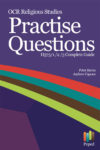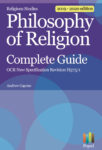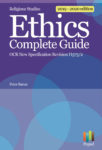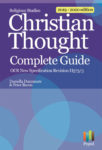Aristotle Sample Answer Part (a)
August 6, 2011
Explain Aristotle’s Understanding Of The Four Causes (25)
This was written in timed conditions (30 minutes). This question was on an examination paper in May 2011 on the Philosophy of Religion (AS). It was written in the hope that students gain a fuller understanding of Aristotle.
Unlike his teacher, Plato, Aristotle believed that the world could be explained by physical observation. This approach of using the five senses, cataloguing and categorising, is the foundation of scientific enquiry and study. The approach is known as empiricism. Plato believed that we needed to look beyond the physical for a metaphysical explanation of the universe in the guise of the World of Forms. Aristotle refuted this.
Aristotle’s understanding of the four causes begins with the assumption that is present in all Greek philosophy, the notion of pre-existing matter. He observed the world around him and noticed that it was in a state of constant flux, a movement from potentiality to actuality. In Metaphysics book XII he uses the example of ‘Whiteness’. Something that is ‘not white’ has the potential to become ‘actually white’ (to actualise this potential), for example my laptop has the potential to run out of battery as I type but is currently in a state of actualised use of battery power. This movement from potentiality to actuality lead Aristotle to the conclusion that there are stages in causation. He called these the four causes: Material, Formal, Efficient and Final causes.
He understood that each of the four causes was necessary to explain the change from potentiality to actuality. His first cause, the material, explained what the object or thing being described was made from. Aristotle used the example of a bronze sculpture and a silver saucer. Bronze or silver in this case would be the material cause. However, objects can have more than one material cause. Take for example my laptop. It is made of wires, plastic, alloys and other materials. These things become the material cause of my laptop.
The second cause takes the formal shape of the object or the pattern which this class of object or thing takes; the definition of the essence as well as the parts included in this definition. It is what we recognise as the thing we are looking at, the statue of David or the laptop itself for example. We can categorise things that we see this way. For Aristotle this is where the ‘form’ that Plato wishes to speak of resides.
His third cause was the efficient cause. To continue Aristotle’s sculpture idea this was the way in which the marble was moved from its state of potentiality to becoming the actual marble statue. A chisel, hammer and sculptor primarily but also a cloth or water perhaps in order to change the material into the shape required. My laptop’s efficient cause may vary from machines and people to plastic moulds and screwdrivers. At this point in the change of causes we have reach an actualisation of the material cause through the efficient cause to arrive at the formal cause of the object.
Lastly in terms of his understanding of causation, the final cause of a thing or object was its purpose (telos). The purpose of the statue is aesthetic in that it is admired; the purpose of my laptop is to help me do my job well. Aristotle uses the example of health being the cause of walking, ‘Why does one walk?’ he asks, ‘that one may be healthy’. This is perhaps the most important of all the causes. Yet his understanding does not end here. Once something has achieved a state of actuality it is also in a state of potentiality. Take ‘whiteness’ again. Once my shirt becomes clean and so ‘white’ it has the potential to become mucky and so ‘not white’ anymore. In this sense we can see that Aristotle saw that the universe was moving constantly between ‘potentiality’ to ‘actuality’ back to ‘potentiality’ once again. This idea required Aristotle to explain things further still because in order for this theory to work it must explain everything in the universe, including the universe itself.
In Metaphysics Book XII, Aristotle identifies three substance categories. Substance category one contains within it things or objects that are subject to decay, that die or change. These things are moved by the four causes from a state of potentiality to actuality. My laptop would be an example of something in category one as it hasn’t always existed in this form and will no doubt give up on me at some point. Substance category two involves things that are subject to the four causes and a change from potentiality to actuality but will never decay, die or cease to exist. Aristotle believed that the universe and time existed in this category because of the Greek notion of pre-existing matter. The question of where ‘matter’ in the universe comes from is a modern one that didn’t trouble him. The final category was ‘substance’ category three. In this category he placed eternal things that are not subject to the four causes, namely, mathematics (the Greeks believed that mathematics existed in a changeless state awaiting discovery) and what he called the Prime Mover. It is the Prime Mover that finishes Aristotle’s understanding of the four causes.
The Prime Mover becomes the efficient and final causes of the universe. Its ‘action’ in the universe is passive. It exists in a state of ‘pure actuality’ incapable of change (otherwise it would enter substance category two), only contemplating its own existence. This is Aristotle’s god. Things are attracted towards the perfection found within its ‘pure actuality’, as Gerry Hughes describes in his example of a cat being drawn to a saucer of milk (purr actuality?). The milk does not act in anyway but by very virtue of it ‘existing’ the cat is drawn to it. This is why the Prime Mover is known as the great attractor. Objects that move from potentiality to actuality fulfil their purpose because their change is brought about through the existence of the Prime Mover (a point later picked up on by Aquinas in his notion of the ‘unmoved mover’). This is how Aristotle explained the final cause of the universe as objects in the universe moved towards their actuality.
To conclude, Aristotle understood the four causes as a movement from potentiality to actuality within certain substance categories. This movement through material, formal, efficient and final causes was ultimately brought about by the Prime Mover.






0 Comments